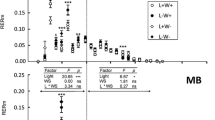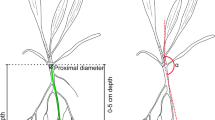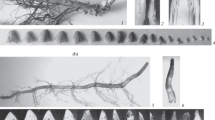Abstract
Retama sphaerocarpa (L.) Boiss. is aMediterranean shrub with a remarkably simplified metameric structure. Terminalyoungest shoots act as units of modular growth, being able to produce newshootsby basal axillary buds (at the base of the shoot) and inflorescencesby lateral axillary buds. In this study, we have analysed the structural andgrowth potential features of these modules, as well as their‘demographic’ proportions, regarding the allocation of newvegetative and reproductive growth in plants of different age. Reproductiveeffort is proportionally higher in older plants. This shift in the allocationstrategy with plant ontogeny is not attained with changes in the shoot modules(which maintain a constant size, nutrient composition and show a similarnew growth investment per module) but through a different‘demographic’ composition of the ‘population’ ofmodulesaccording to their developmental fate (vegetative or reproductive).This indicates a high level of iterativity and a purely modular growth, sincethe attributes of the individual (age of the plants) do not seem toaffect those of the integrating modular units (growth performance of theshoots).
Similar content being viewed by others
References
Acosta F.J., Delgado J.A., López F. and Serrano J.M. 1997. Functional features and ontogenetic changes in reproductive allocation and partitioning strategies of plant modules. Plant Ecology 132: 71–76.
Ashman T.-L. 1994. A dynamic perspective on the physiological cost of reproduction in plants. The American Naturalist 144: 300–316.
Bell A.D. 1991. Plant form. Oxford University Press, Oxford.
Braby M.F. and Jones R.E. 1995. Reproductive patterns and resource allocation in tropical butterflies: influence of adult diet and seasonal phenotype on fecundity, longevity and egg size. Oikos 72: 189–204.
Evans R.D. and Black R.A. 1993. Growth, photosynthesis, and resource investment for vegetative and reproductive modules of Artemisia tridentata. Ecology 74: 1516–1528.
Fox J.F. 1995. Shoot demographic responses to manipulation of reproductive effort by bud removal in a willow. Oikos 72: 283–287.
Geber M.A. 1990. The cost of meristem limitation in Polygonum arenastrum: negative genetic correlations between fecundity and growth. Evolution 44: 799–819.
Hallé F. 1986. Modular growth in seed plants. Philosophical Transaction of the Royal Society of London B 313: 77–87.
Harper J.L. 1981. The concept of population in modular organisms. In: May R.M. (ed.), Theoretical Ecology, Principles and Applications. 2nd edn. Blackwell Scientific Publications, Oxford, pp. 53–77.
Harper J.L. and Bell A.D. 1979. The population dynamics of growth form in organism with modular construction. In: Anderson R.M. (ed.), Population Dynamics. Blackwell Scientific Publications, Oxford, pp. 29–52.
Harper J.L. and White J. 1974. The demography of plants. Annual Review of Ecology and Systematics 5: 419–463.
Huber H., Lukács S. and Watson M.A. 1999. Spatial structure of stoloniferous herbs: an interplay between structural blue-print, ontogeny and phenotypic plasticity. Plant Ecology 141: 107–115.
Hurlbert S.H. 1984. Pseudoreplication and the design of ecological field experiments. Ecological Monographs 54: 187–211.
Kawano S. and Masuda J. 1980. The productive and reproductive biology of flowering plants. Oecologia 45: 307–317.
King D. and Roughgarden J. 1982a. Multiple switches between vegetative and reproductive growth in annual plants. Theoretical Population Biology 21: 194–204.
King D. and Roughgarden J. 1982b. Graded allocation between vegetative and reproductive growth for annual plants in growing seasons of random length. Theoretical Population Biology 22: 1–16.
Klinkhamer P.G.L., Meelis E., de Jong T.J. and Weiner J. 1992. On the analysis of size-dependent reproductive output in plants. Functional Ecology 6: 308–316.
Kozlowski J. 1992. Optimal allocation of resources to growth and reproduction: implications for age and size at maturity. Trends in Ecology and Evolution 7: 15–19.
Lacey E.P. 1986. Onset of reproduction in plants: size-versus agedependency. Trends in Ecology and Evolution 7: 15–19.
Langley P.A. and Clutton-Brock T.H. 1998. Does reproductive investment change with age in tsetse flies, Glossina morsitans morsitans (Diptera: Glossinidae)? Functional Ecology 12: 866–870.
Lovett Doust J. 1989. Plant reproductive strategies and resources allocation. Trends in Ecology and Evolution 4: 230–234.
Maillette L. 1982. Structural dynamics of silver birch. I The fates of buds. Journal of Applied Ecology 19: 203–218.
Maillette L. 1992a. Seasonal model of modular growth in plants. Journal of Ecology 80: 123–130.
Maillette L. 1992b. Plasticity of modular reiteration in Potentilla anserina. Journal of Ecology 80: 231–239.
McGraw J.B. and Garbutt K. 1990. The analysis of plant growth in ecological and evolutionary studies. Trends in Ecology and Evolution 5: 251–25.
Obeso J.R. 1997. Cost of reproduction in Ilex aquifolium: effects at tree, branch and leaf levels. Journal of Ecology 85: 159–166.
Preston K.A. 1998. Architectural constraint on flower number in a photoperiodic annual. Oikos 81: 279–288.
Pugnaire F.L., Haase P., Puigdefàbregas J., Cueto M., Clark S.C. and Incoll D. 1996. Facilitation and succession under the canopy of a leguminous shrub, Retama sphaerocarpa, in a semiarid environment in south-east Spain. Oikos 76: 455–464.
Schmid B. 1990. Some ecological and evolutionary consequences of modular organization and clonal growth in plants. Evolutionary trends in plants 4: 25–34.
Shykoff J.A. and Müller C.B. 1995. Reproductive decisions in bumble-bee colonies: the influence of worker mortality in Bombus terrestris (Hymenoptera, Apidae). Functional ecology 9: 106–112.
Smith B.H. 1984. The optimal design of a herbaceous body. The American Naturalist 123: 197–211.
Waller D.M. 1986. Acquisition and utilization of resources. In: Crawley M.J. (ed.), Plant Ecology. Blackwell Scientific Publications, Oxford, pp. 291–320.
Walsh L.M. 1971. Instrumental methods for analysis of soils and plant tissue. Soil Science Society of America, Madison, Wisconsin.
Watkinson A.R. 1986. Acquisition and utilization of resources. In: Crawley M.J. (ed.), Plant Ecology. Blackwell Scientific Publications, Oxford, pp. 137–184.
Watkinson A.R. and White J. 1985. Some life-history consequences of modular construction in plants. Philosophical Transaction of the Royal Society of London B 313: 31–51.
Watson M.A. 1984. Developmental constraints. Effects on population growth and patterns of resource allocation in a clonal plant. The American Naturalist 123: 411–426.
Watson M.A. 1986. Integrated physiological units in plants. Trends in Ecology and Evolution 1: 119–123.
Watson M.A. and Casper B.B. 1984. Morphogenetic constraints on patterns of carbon distribution in plants. Annual Review of Ecology and Systematics 15: 233–258.
Watson M.A., Hay M.J.M. and Newton P.C.D. 1997. Developmental phenology and the timing of determination of shoot bud fates: ways in which the developmental program modulates fitness in clonal plants. In: de Kroon H. and van Groenendael J. (eds), Backhuys Publishers, Leiden, The Netherlands, pp. 31–53.
White J. 1979. The plant as a metapopulation. Annual Review of Ecology and Systematics 10: 109–145.
Yampolsky L.Y. and Ebert D. 1994. Variation and plasticity of biomass allocation in Daphnia. Functional Ecology 8: 435–440.
Author information
Authors and Affiliations
Rights and permissions
About this article
Cite this article
López, F., Fungairiño, S., de las Heras, P. et al. Age changes in the vegetative vs. reproductive allocation by module demographic strategies in a perennial plant. Plant Ecology 157, 13–21 (2001). https://doi.org/10.1023/A:1014597832475
Published:
Issue Date:
DOI: https://doi.org/10.1023/A:1014597832475




